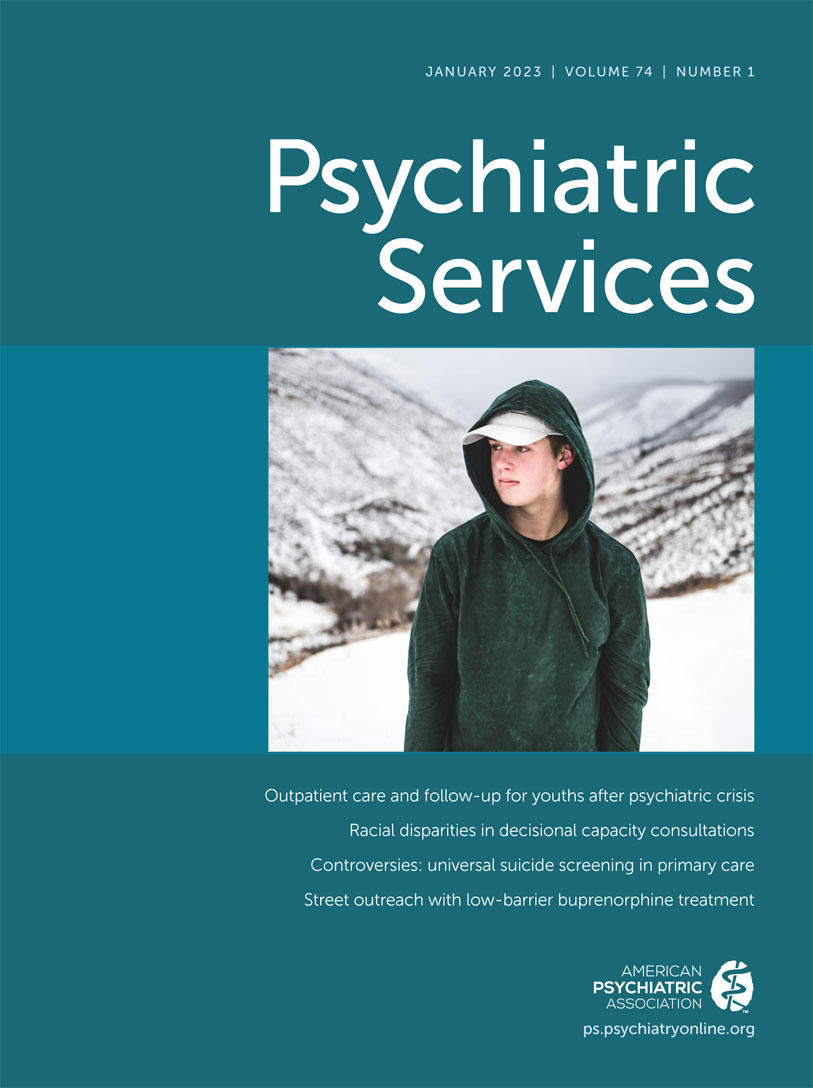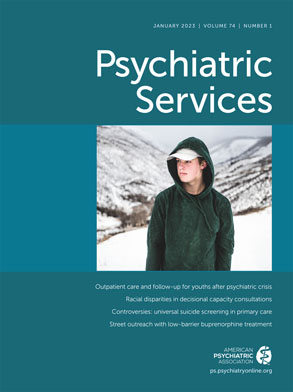Recent recommendations from regulatory agencies such as the Joint Commission on the Accreditation of Healthcare Organizations (JCAHO) require that patients who are primarily evaluated or treated for behavioral health conditions in hospital settings be screened for increased suicide risk (i.e., targeted screening). However, four patterns in the emerging empirical literature, reviewed below, suggest that universal rather than targeted screening should be considered to optimize identification of adults and children at risk of suicide. With universal screening, all patients in both medical and mental health settings are screened for suicide risk, regardless of the reason for their visit. Irrespective of whether a targeted or universal screening model is used, a validated tool should guide the screening, and a robust clinical workflow that specifies expected care practices for those determined to be at risk for suicide should be in place.
There are several reasons to consider adopting universal suicide risk screening. First, visits to health care providers offer an opportunity to identify people at risk who might not otherwise be identified. More than 80% of people who die by suicide interact with health care services in the year before their death, often for nonpsychiatric reasons, and only half who die by suicide have a diagnosed mental health condition at the time of their death (
1). Thus, targeted screening among only those with known behavioral health disorders will miss many if not most adults and children at risk.
Second, studies suggest that universal screening in busy health care settings is feasible (
2,
3). The results of a study of universal screening among adult emergency department (ED) patients indicate that >85% of the general adult population could be screened once protocols are established (
4). In a pediatric ED study, patients underwent suicide screening while they were waiting to be seen by a physician, and length of stay in the ED was not affected by the screening. Pediatric patients and their parents or loved ones are generally supportive of screening nonpsychiatric patients (
3).
Third, when health care facilities have moved from targeted to universal screening, detection of nascent or occult suicide risk improves. In a study of universal screening among adults presenting to the ED, screening led to a nearly twofold improvement in suicide risk detection, rising from 2.9% to 5.7% (
4). In a pediatric sample of 15,000 youths screened in a pediatric hospital, 55% of those who screened positive on the screener did not present to the ED with suicidal ideation or behavior as their presenting problem (
5). Further, the percentage of eligible participants who were actually screened ranged from 59% to 81% during the targeted screening phase and from 80% to 86% during the universal screening phase, meaning that targeted screening (i.e., only screening those with known primary behavioral health issue) elicited uncertainty among members of the health care team with regard to who should be screened, and youths were therefore missed. Results of this study also suggested that increased suicide risk among male and Black patients, for whom suicide rates have skyrocketed, was more likely to be detected with universal screening than with targeted screening. Achieving equity in identifying suicide risk in minoritized populations may require multiple approaches, including universal screening.
Fourth, best practices exist for addressing suicide risk and, when deployed, can reduce subsequent risk, but they are vastly underutilized (
6). Most primary health care providers, including psychologists, have received very little training in best practices for assessing and managing suicide risk despite the availability of these practices (
6). Universal screening requires training for the staff conducting the screen, most often a nurse, either during triage or primary nursing assessment, followed by a secondary risk assessment with higher specificity, often delivered by a physician, advanced practice provider, or mental health clinician. Established protocols need to be in place to conduct the assessment and to document, communicate, and respond to increased suicide risk. Health care providers can be trained, at a minimum, to provide brief, meaningful interventions that reduce suicidal behaviors, such as safety planning, reducing access to lethal means, and caring contacts, and to facilitate referrals to behavioral health specialists.
Some widely held myths and perceived potential barriers to universal screening likely still prevail, contributing to the controversy surrounding the feasibility and rationale for universal screening (e.g., myths that asking about suicide puts the idea in someone’s head, that not much can be done for people who want to die, and that suicidal people often are not honest on screeners; lack of awareness of effective brief interventions, lack of resources, and concern about false-positive rates of a screening tool). Other concerns include shortage of time to address the suicidality and availability of appropriate referrals. Studies suggest that staff knowledge, confidence, and investment in suicide risk assessment increases with training about how to use the instruments. Many of these obstacles and concerns—whether real, perceived, or suppositious—can be rectified with proper training, reallocation of staff, and determination that suicide prevention is a core responsibility of the health care system.
Although adoption of universal screening is inherently associated with increased burdens in clinical settings, these burdens can be overcome. Rollout of universal screening must be coordinated by a multidisciplinary team to include leadership, frontline staff, performance improvement personnel, and information technology specialists to design the protocol, workflow, and training and to oversee implementation of the screening. Depending on how much work has already been done in a health system, this effort can vary widely. Systems that have already become compliant with JCAHO standards, for example, may not require much additional work to transition to universal screening. However, systems that have not recently completed any performance improvement work on their suicide risk screening and mitigation will need to undertake considerable efforts to ensure that their screening procedures and associated mitigation pathways are complete. No published estimates are available for these efforts, but at the University of Massachusetts Memorial Health system, we found that it takes at least 200 hours of preparatory work to roll out protocols for each level of care—ED, inpatient units, and ambulatory units—even though this system had already completed a modest amount of work preparing for JCAHO. Training staff to utilize the screening protocols is critical and may vary from 5 to 10 minutes to multiple hours, depending largely on whether safety planning is conducted in response to positive screening results. Universal screening will require extra effort compared with targeted screening. Most tools designed for initial screening are short, usually consisting of only a few questions. Responding to a positive response on Patient Health Questionnaire item 9 with a more thorough screening, such as the Columbia Suicide Severity Rating Scale–Screening (CSSR-S) version, will add a few minutes of screening time. Adding the CSSRS-S to every visit, not just for individuals with a positive response on item 9, will add approximately 30 seconds for those who screen negative and up to 5 minutes for those who screen positive on the CSSRS-S instrument.
The evidence is clear that it is possible to identify most individuals with greatly elevated suicide risk by using brief and easy-to-administer tools, allowing us to provide targeted, effective supports during the period where their risk remains high. Consider the parallel of screening for heart disease—routine visits to the ED or to primary care include blood pressure and weight measurement. These are “screeners” for potential underlying medical issues that would need to be addressed, regardless of the primary reason for the patient’s visit. The public and the health care work force are comfortable providing and receiving this routine care and expect it at each visit. If risk for heart disease appears to be elevated, effective countermeasures exist that are prescribed to or discussed with the patient (e.g., a statin prescription or recommendation to stop smoking). As with suicide, health care organizations cannot predict exactly who will develop cardiac disease. But as with suicide, we can identify people whose risk is high and prescribe treatments to reduce this risk. We should treat suicide prevention in health care systems as we treat cardiac disease prevention, with an emphasis on preventive interventions for individuals with elevated risk. Universal screening allows providers to detect this risk and provide brief, effective interventions for those who screen positive.
Suicide is complex, and our ability to accurately predict future suicide attempts and deaths still requires much research. Ideally, biomarkers and improved risk measurement, such as machine-learning algorithms used with electronic health record data, will become effective tools to detect suicide risk rather than relying on traditional screeners. Regardless of the method used to identify risk during screening, however, one cannot rely on screening tools alone to determine level of care and guide treatment planning. A combination of an evidence-based screening tool followed by a comprehensive risk assessment, good clinical judgment, and meaningful connection to the patient are also required.
In conclusion, current standards recommending screening only for those presenting to health care settings with a primary behavioral health condition risk missing many patients who are at risk for suicide, wasting what may be the only opportunity to prevent a suicide attempt or death. The data are clear: application of universal screening for suicide risk is feasible in health care, improves identification of risk, makes identification more equitable across racial groups, and, when combined with an intervention, reduces the probability of future suicidal behavior.

